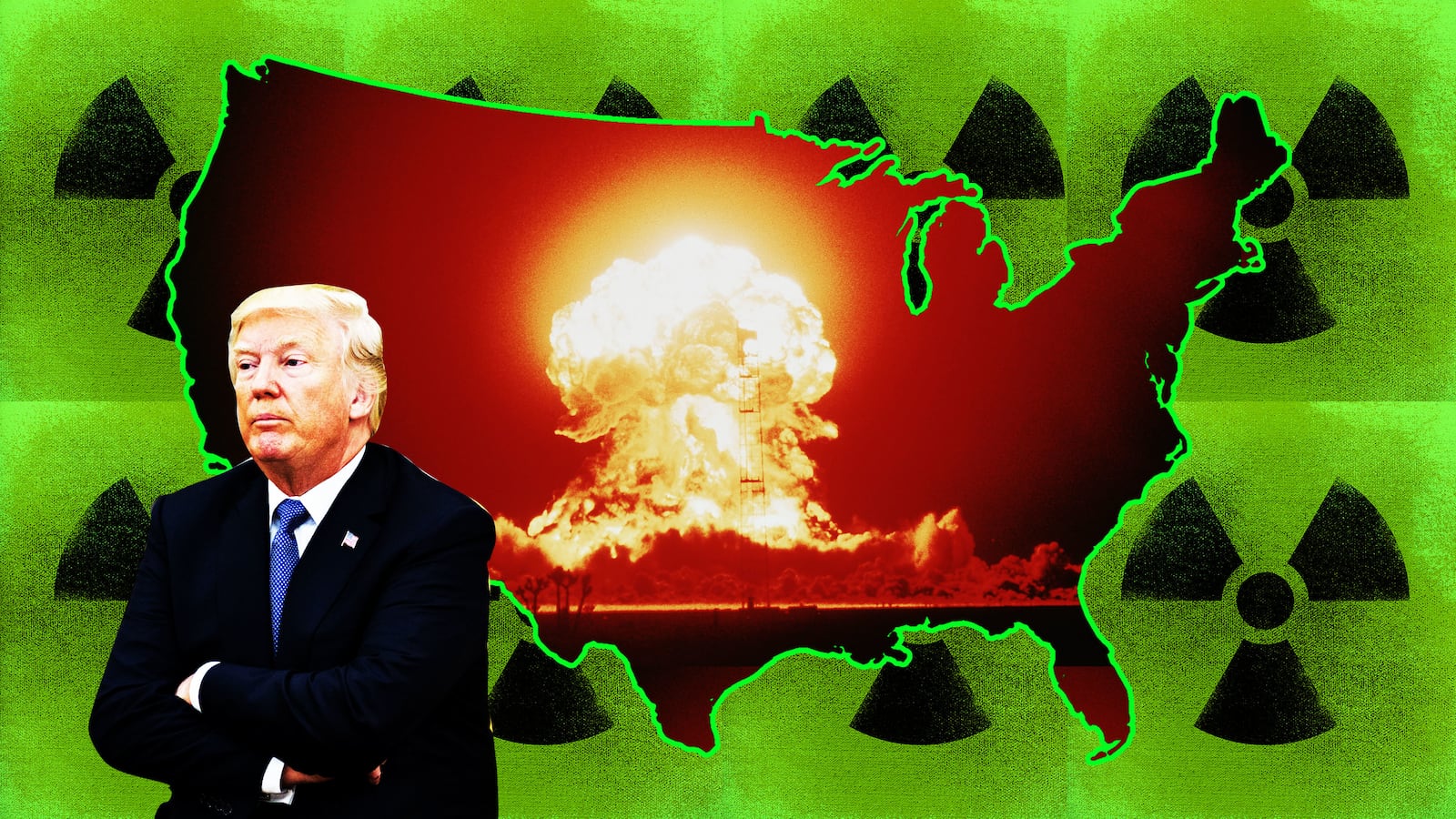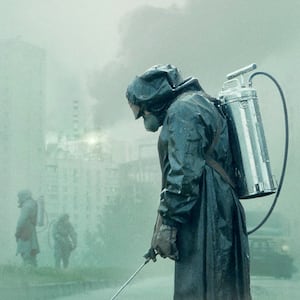HBO’s Chernobyl is terrifying and engrossing drama but its creator, Craig Mazin, also intended it to be a modern parable. He says he was motivated partly to present it as a riposte to the global war on truth.
Actually, it can be seen as more than that. It serves as a salutary warning of the global war on scientific truth.
The villain of the story is not a single character but the collective Soviet system of governance. George Orwell nailed the essence of this style of totalitarianism when he wrote, “Political language is designed to make lies sound truthful and murder respectable, and to give an appearance of solidity to pure wind.”
In Mazin’s narrative there are two kinds of casualties. As the disaster at the Chernobyl nuclear plant unspools, some of the lead players are radiated into a mass of pustules. But the first casualty on screen is truth – delivered in the opening scene when the saint and martyr of the story, Valery Legasov, played with perfect pitch by Jared Harris, utters the thematic message: “What is the cost of lies? Can we no longer recognize the truth at all?”
Later in Moscow the assembled apparatchiks, seated before their leader Mikhail Gorbachev, do their best to swat away Legasov’s warning that if they don’t get their act together fast a vast swath of Central Europe will be rendered uninhabitable for 100 years.
Gorbachev, viewed by history as the decisive mortician of the Soviet Union, is portrayed here as surprisingly irresolute. You sense that he might well be asking, like Henry II, “will no one rid me of this turbulent priest?”
I found some of these scenes riskily close to Armando Iannucci’s masterful parody The Death of Stalin where the politburo reaches levels of self-abasement worthy of Mitch McConnell. But Mazin is deadly serious in setting up Legasov as a whistleblower who will eventually be crushed and rendered into a nonperson as the system closes ranks.
And that’s where Chernobyl—not as drama but as parable—misleads and misfires. It lulls us into the false comfort of believing that only a system as decayed as Russia’s could so ruthlessly treat scientific truth as a disobliging heresy, even when millions of lives could be at risk by suppressing it.
To see it that way in Trump’s America would be the ultimate hypocrisy. The Trump administration is engaged in an attack on scientific truth every bit as brazen as anything in the history of the Soviet Union as it sweeps aside all warnings about the consequences of climate change.
Indeed, climate change can be seen like a slow motion version of Chernobyl on a far larger scale—a runaway failure of control over forces of enormous energy with the entire planet at risk. In responding to it the White House has come to resemble a kind of bastard combination of deregulated capitalism and Soviet-style perversion of language, an American version of the politburo.
When Trump was in London his personal meeting with Prince Charles was prolonged 75 minutes longer than planned because Charles made a determined attempt to persuade him that climate change was man-made and only a change in political will could avert a catastrophe.
“He did most of the talking,” Trump conceded in an interview with Piers Morgan, showing unusual deference. But then he proceeded to deliver an outrageously Panglossian picture entirely unsupported by facts: “The U.S. right now has among the cleanest climates based on all statistics. It’s even getting better because I agree we want the best water, the cleanest water. It’s crystal clean.”
This from a president who from his first days in office made it clear that America would abscond from the Paris climate accords and then set out to castrate the Environmental Protection Agency, ordered the removal of all mention of climate change from EPA websites, and attempted to roll back protections for clean water.
But as with so many of the regressive actions of this White House it is a mistake to respond to them as though they are the work of Trump alone. When you start to look at this peculiar American adaptation of Soviet-speak it’s a lot more sinister than that.
Trump is the face and voice of this change of regime because he is always consumed with the need to personally own it. This kind of megalomania was something that the Soviet system suffered but eventually rejected – after the death of Stalin it was denounced as the cult of personality and future Russian leaders (until Putin) were careful not to repeat it.
Trump’s erratic and seemingly impulsive declarations help to conceal the much more deliberative and consistent policy process behind him.
All those Republican senators who have to suffer the indignity of appearing to be Trump toadies don’t really care because they have waited decades for a White House with the balls to roll back all the science-based compromises made by previous Republican presidents—starting with Richard Nixon and his acceptance of the need for a government role in environmental protection and including George Bush senior’s final acceptance of the link between cancer and smoking.
In fact, it’s significant that the settlement that Big Tobacco made with 46 states, guaranteeing $206 billion over 25 years as compensation for the health-care impact of smoking, is being used as the model for liability lawsuits being brought against fossil fuel companies by some states and the state of Rhode Island. Sheldon Whitehouse, the Democratic senator from Rhode Island, told the Financial Times that the comparisons were clear: “If you pop out the word tobacco and put in the words fossil fuels, pop out health and put in environmental harms, the complaint writes itself.”
Bush senior was also responsible for the substantial 1990 reinforcement of the Clean Air Act to deal with acid rain, urban air pollution and toxic air emissions. (George W. Bush did not follow his father’s lead. His administration frequently tried to dial back official warnings of the mounting evidence of the climate threats.)
In this running conflict between vested industrial interests and science the emerging issue of climate change was always going to present the biggest threat. After all, the industrial foundations of modern American capitalism were largely constructed on the abundance of fossil fuels.
From the emergence of John D. Rockefeller’s Standard Oil cartel to the Koch brothers’ empire of smokestack pollution the idea has persisted that unfettered access to and use of fossil energy sources is a God-given blessing to the people of America that should be defended by any means possible.
A strong part of that defense has been to try to turn science against science in a way that had not been so easy with the earlier issues.
For example, there was irrefutable evidence in plain sight that the environment needed cleaning up. Once cigarettes were exposed as a nicotine delivery system there was irrefutable evidence that smoking caused cancer. But the real effects of climate change are not so clearly in plain sight—climate science, as advanced as it is, is a scientific projection of the future not an empirical certainty.
Even today as Arctic glaciers melt, wildfire infernos engulf California, unprecedented floods drown the Midwest, tornadoes become deadlier and more frequent, and ocean tides surge up through the storm drains of Florida there are scientists like Steven Koonin, who served in the Department of Energy under Obama for 18 months, and argue that the science is “not settled.”
Koonin is a supporter of William Happer, the Princeton physicist, who in 2014 declared that “The demonization of carbon dioxide is just like the demonization of the poor Jews under Hitler.” Happer now serves on the National Security Council as deputy assistant for emerging technologies.
And it’s true that it cannot be proved conclusively how any of these events fit into the long-term picture of climate upheaval—if, that is, you want to wait for proof before acting.
By then, of course, it will be too late. It’s rather like the scenes in Chernobyl when the inhabitants of nearby towns stare in wonderment at the strange beauty of the luminescence in the night sky without realizing that it carries death in a billion dancing particles.

"CHERNOBYL, UKRAINE : View of the Chernobyl Nuclear power after the explosion on April 26 1986 in Chernobyl:,Ukraine. (Photo by SHONE/GAMMA/Gamma-Rapho via Getty Images)"
SHONEWhen U.S. government scientists issued their fourth National Climate Assessment last November, as mandated by law, they said it was no longer tenable to wait for more proof: global warming would cause lasting economic damage.
Trump’s response was “I don’t believe it.”
The Assessment had undergone a peer review by a committee of the National Academies of Sciences, Engineering and Medicine but the White House countered with a chorus of climate change deniers, including Danielle Pletka of the American Enterprise Institute who, after declaring that she was not a scientist, said that the last two years had been the coldest on record—when they had been among the hottest.
The White House has recently invented a new corruption of science: enforced myopia. They appointed James Reilly as director of the United States Geological Survey—who then ordered that computer modeling of the impact of climate change should be curtailed beyond 2040, knowing that its most severe effects will be seen in the second half of the century.
There isn’t a more basically Soviet propaganda device than denial. And yet the whole onslaught by fossil-fuel interests on climate science has been predicated on the principle of denial—accompanied by what Kellyanne Conway unwisely defined, in exquisitely Orwellian terms, as “alternative facts.”
Where the American Enterprise Institute and the techniques of Soviet propaganda converge is in their understanding of the wide appeal of denial. Given the choice between reality and reality deferment, many people are happy to accept deferment.
The Democratic National Committee appears to share this view. Jay Inslee, the governor of Washington State and the only candidate in the party running for president to make climate change the basis of his platform, was denied a request to make the issue the sole subject of one of the upcoming 12 debates.
If the Democratic Party machine really believes that facing up to the reality of the greatest single threat to the planet and to the safety of future generations is not a winning strategy they can’t really claim any moral advantage over the Republicans.
Chernobyl’s meltdown was contained. Much of the surrounding area was rendered uninhabitable but Central Europe did not have a nuclear winter. It was a close-run thing. Mazin’s drama shows how an interplay of incompetence, bureaucratic infighting and the ingrained habit of covering up was, luckily for the rest of the world, countered by scores of individual acts of courage.
But Chernobyl spooked many countries into either closing down nuclear power plants or spurning them altogether. And that, in turn, is exacerbating climate change. Nearly 40 percent of the world’s power is generated by coal burning plants, only 11 percent by nuclear, which is clean. In 2018 there was a 2-percent increase in the world’s carbon emissions—partly as a result of the demands for more air conditioning in cities experiencing new levels of summer heat.
Mazin’s script has been criticized for some of the creative liberties he took. There was never really much of a mystery about the causes of the disaster yet he makes unearthing those causes into a plot-driver. Ulana Khomyuk, the female lead played by Emily Watson, never existed. She is a composite representing women scientists who had to live under the edicts of the party hacks.
And Valery Legasov was not the hero of a show trial as he is made out to be. “Every lie we tell incurs a debt to the truth” he says, “Sooner or later that debt is paid. That is how an RBMK reactor explodes.”
Those are Mazin’s words, not Legasov’s, as he completes his own suicide message.
Legasov did kill himself. There was a deadly flaw in the supposedly fail-safe system intended to shut down a reactor in an emergency, and that flaw was later corrected without admitting that only a negligent system would have allowed it in the first place.
None of this really matters in judging the effect of the parable. After all, this is not a documentary. The spectacle of scientists and politicians talking past each other in their separate languages has never been better drawn. Soviet scientists knew they could never break the bounds of conformity imposed by the system.
And now we know that this was not uniquely confined to the Soviet Union. This White House has never thought that any lie incurs a debt to the truth, and in its own attempt to suppress scientific truth is as careless with public safety as the politburo. To us Legasov’s desperate question, What is the cost of lies?, carries more menace than he could possibly have imagined.



